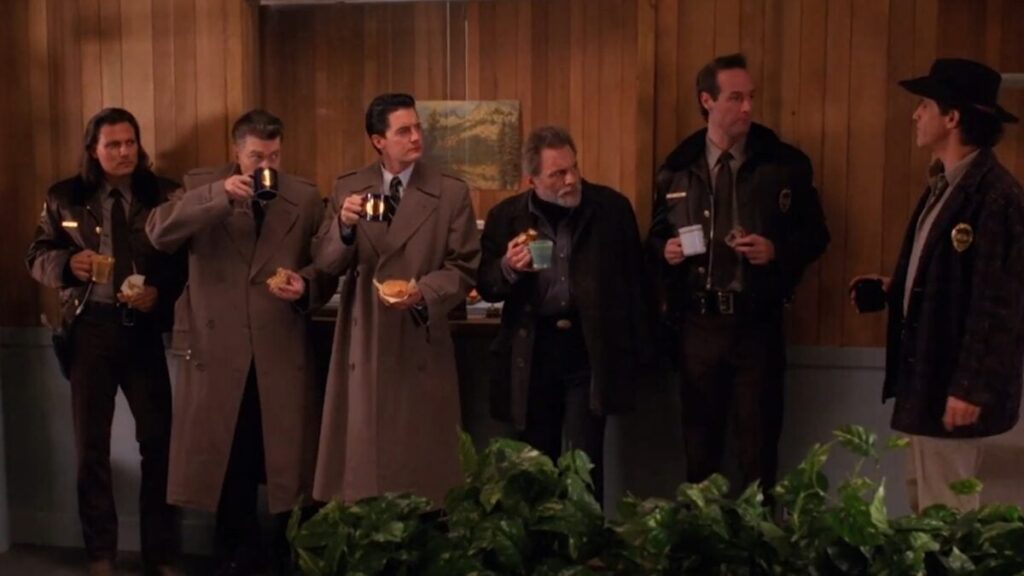With the chill air, the sky getting darker earlier, and sweaters and warm drinks feeling extra cozy, the fall season is in full effect. Likewise, it feels appropriate to learn that Twin Peaks, a show that evokes the same flavor of fall vibes, achieved its cozy look (despite that major murder) under the direction of the late David Lynch. Turns out Lynch’s unique direction seemed to come in the form of vivid metaphors given to the show’s director of photography, Ronald Víctor García, to suss out and make it happen.
Speaking at the Camerimage film festival during a tribute to Lynch, Garcia gave fans behind-the-scenes details on the kind of direction Lynch gave him to make Twin Peaks and Twin Peaks: Fire Walk With Me look so distinctive. While anyone who’s had the pleasure to watch Twin Peaks’ disarmingly calming opening theme by Angelo Badalamenti knows the show immediately arrests your attention sonically, easing you into the kind of off-kilter, slow-moving murder mystery one agent, Dale Cooper, is tasked to solve (at his own pace), Garcia regaled the crowd by telling them that Lynch’s unique way of describing (or not describing) meaning with his works also pertained to his direction at Garcia to nail its mood.
“He wanted something warm,” Garca said, according to The Hollywood Reporter. “Everybody shoots the Northwest, up in Washington State, in blue. The forest in blue, cold colors. David didn’t want blue. He wanted warmth.”
Garcia went on to credit his experience with Fuji stock (in tandem with an 85 correction filter and Pure Glass LLC filter for all the cinematography whizzes out there) as the tools he used to achieve its vintage look, saying, “The Fuji film could really reach into the shadow area and make the dark shadows warmer, just enough to where it changed the look of the film.”
Of course, having the tools to do so doesn’t account for the learning curve in implementing them. Which, as we noted up top, came in the form of metaphor-drenched directions from Lynch. Although Lynch was described to rarely dole out technical directions, the first hurdle Garcia encountered with his shooting style was that Garcia, and TV more broadly, moved too fast for Lynch’s liking.
“I was used to television—you got three seconds and it’s cut—so I was speeding along. He kept saying, ‘Ron, it’s too fast.’ We had that five times,” Garcia continued. “Finally he looked at me and said, ‘Ron. Think underwater.’ I pictured myself in a swimming pool trying to walk against the thickness of water, and that was it—perfect.”
Another choice/vague Lynchian direction note Garcia recalled was when he got a call from Lynch about his establishing shots for season 1, saying, “Ron, too weird. Think mysterious,” before promptly hanging up. Garcia says Lynch was the same with Twin Peaks‘ actors when doling out advice to nail the vibe he was going for with the show.
“Because of his meditation, he was present every moment,” Garcia said. “He was able to see who he was talking to and reach into your psyche without many words.”
Thankfully for Garcia, his faster pacing would fit in nicely with the inverse pacing of Fire Walk With Me to the point that Lynch got so used to it that he would have it pop back up in The Missing Pieces. For Garcia, Lynch’s direction was a boon when he later worked with Michael Mann on the second season of NBC’s Crime Story. Suffice to say, the two directors’ styles were night and day.
“Shooting with Michael Mann, it was like being on the bullet train in Japan. Shooting with David Lynch was like being in a canoe on a very calm lake,” Garcia said.
Photo: (Showtime)
Before ending, Garcia had some smoke for how Hollywood doesn’t make shows the way they used to, pointing much of his 85-year-old ire at all the tech new TV shows use to create what he describes as a drab aesthetic.
“I hate to say this, but I think it all looks the same. And it’s because of AI, CGI, the technology and the special effects taking over the whole ball of wax,” Garcia said. “I’m here at Camerimage to watch foreign films, not Hollywood films, because I’m interested in what the cinematographers are doing. I think the creativity comes out of having not enough equipment and not enough time and having to find a solution.”
Considering just how much Twin Peaks holds up all these years later, and how often we all complain about murkily shot streaming shows we can barely see, maybe Garcia has a point.
Want more io9 news? Check out when to expect the latest Marvel, Star Wars, and Star Trek releases, what’s next for the DC Universe on film and TV, and everything you need to know about the future of Doctor Who.

